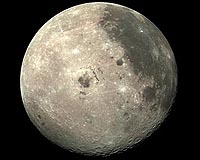 |
Canberra, Australia (SPX) Sep 21, 2009 Using cameras which capture fireballs streaking across the night sky and sophisticated mathematics, a world-wide team of scientists have managed to find not only a tiny meteorite on the vast Nullarbor Plain, but also its orbit and the asteroid it came from. The research team, including CSIRO scientist Dr Rob Hough, was led by Professor Phil Bland of Imperial College London. The remarkable "detective" work was detailed in a paper published in Science on September 18, 2009. Meteorites discovered with known orbits are incredibly rare, so the achievement is a remarkable breakthrough in planetary science. The ability to track meteorites back to their asteroid home also means it is an incredibly cheap way of sampling that asteroid, rather than conducting an expensive space mission. To find the meteorite, the team deployed three 'all sky cameras' on the Nullarbor Plain to form a fireball camera network. The cameras take a single time lapse picture of the sky throughout the entire night to record any fireballs over the Plain. Combined with some clever mathematics, researchers were then able to calculate the original orbit of the object and where to search for the meteorite on the ground. CSIRO Exploration and Mining scientist and co-author of the paper Dr Rob Hough said the search for the meteorite was helped by the fact the Nullarbor Plain is marked by white limestone rocks. "So a dark meteorite on the white surface is easier to find, however it's very tiny, so the discovery is still really quite amazing," Dr Hough said. "This particular meteorite is also very interesting because of its rarity. It is an achondrite - a basalt - with a composition that suggest an asteroid from the inner asteroid belt." Dr Hough said the 'all sky camera' network had been an extremely successful project and had spotted many fireballs. "The Plain is a very difficult place to have technology like the cameras and the fieldwork to find the meteorite is not trivial," he said. "The logistics are a really important aspect of a project like this and it takes a lot of planning to make it work." The Science paper describes the first find of a meteorite from the camera network. Western Australia Chief Scientist Professor Lyn Beazley described it as an extremely exciting finding, which will help us understand the evolution of the solar system. "It will complement Western Australia's radio astronomy research and, in particular, Australia's commitment to the Square Kilometre Array radio telescope, " Professor Beazley said. "This also represents an extraordinary collaborative effort between CSIRO, the Western Australian Museum and academics from the UK and takes advantage of the unique features of Western Australia, which allows the tracking, locating and collecting of rare meteorite material." Share This Article With Planet Earth
Related Links CSIRO Exploration and Mining Asteroid and Comet Impact Danger To Earth - News and Science
 Earth Rocks In Space
Earth Rocks In SpaceSydney, Australia (SPX) Sep 14, 2009 Rocks from space fall to Earth all the time. Meteorite fragments are so common that they turn up in jewelry. Some of these fragments have been found to come from the Moon and Mars, giving us a very cheap form of sample retrieval. They're blown off the surface of these worlds when a large object impacts the surface, creating a massive explosion. Drifting through space for eons, they ... read more |
|
| The content herein, unless otherwise known to be public domain, are Copyright 1995-2009 - SpaceDaily. AFP and UPI Wire Stories are copyright Agence France-Presse and United Press International. ESA Portal Reports are copyright European Space Agency. All NASA sourced material is public domain. Additional copyrights may apply in whole or part to other bona fide parties. Advertising does not imply endorsement,agreement or approval of any opinions, statements or information provided by SpaceDaily on any Web page published or hosted by SpaceDaily. Privacy Statement |